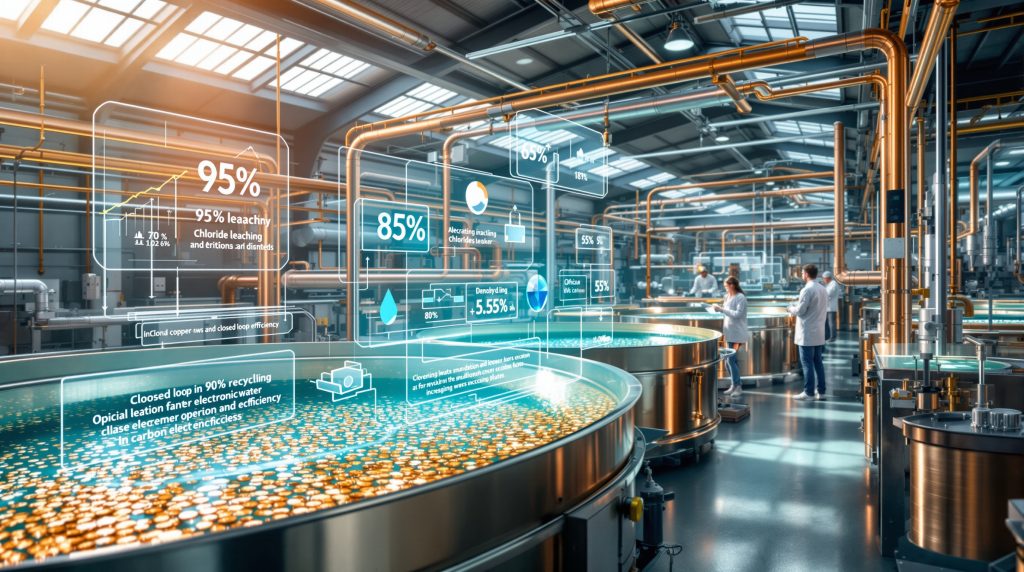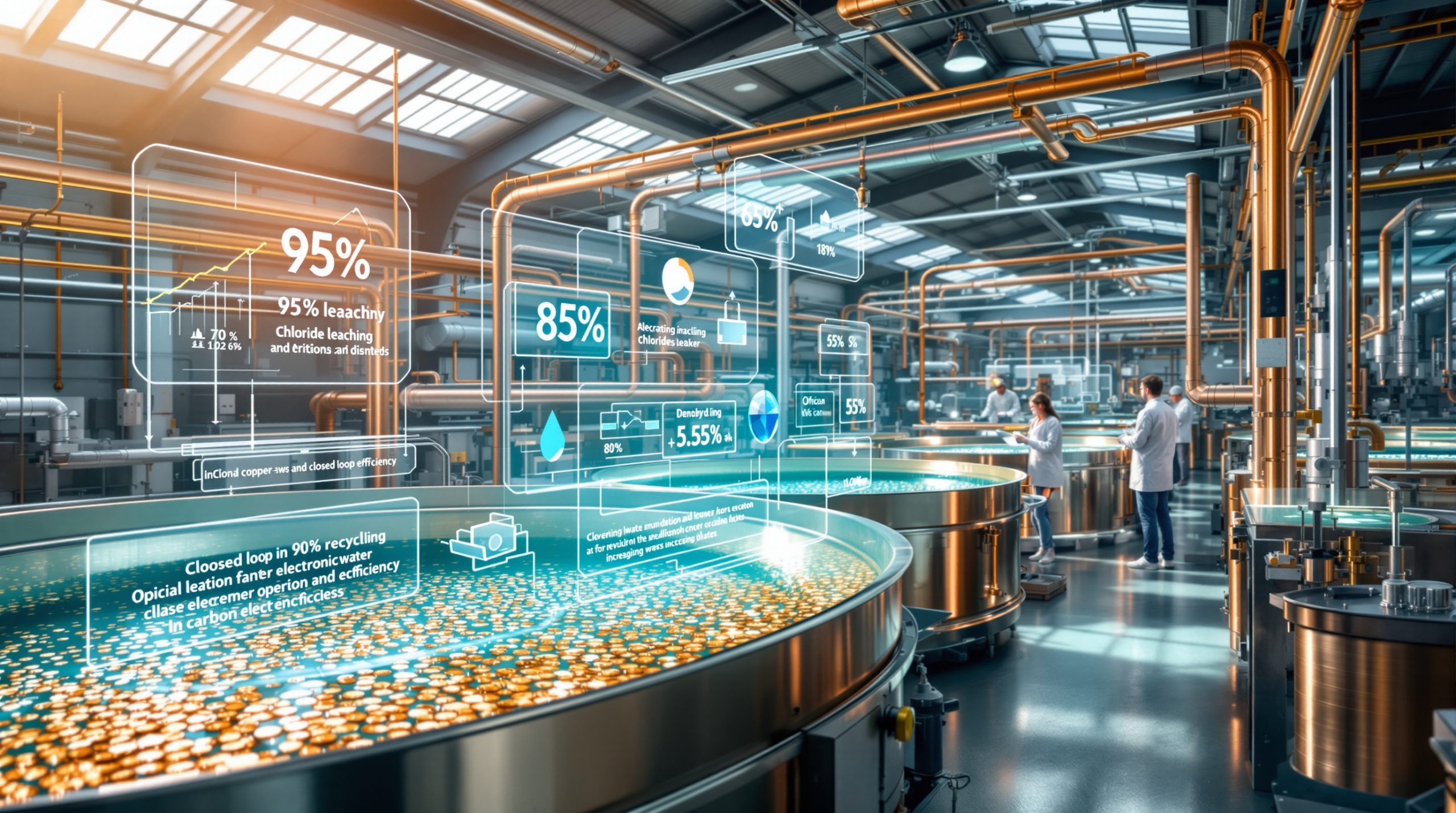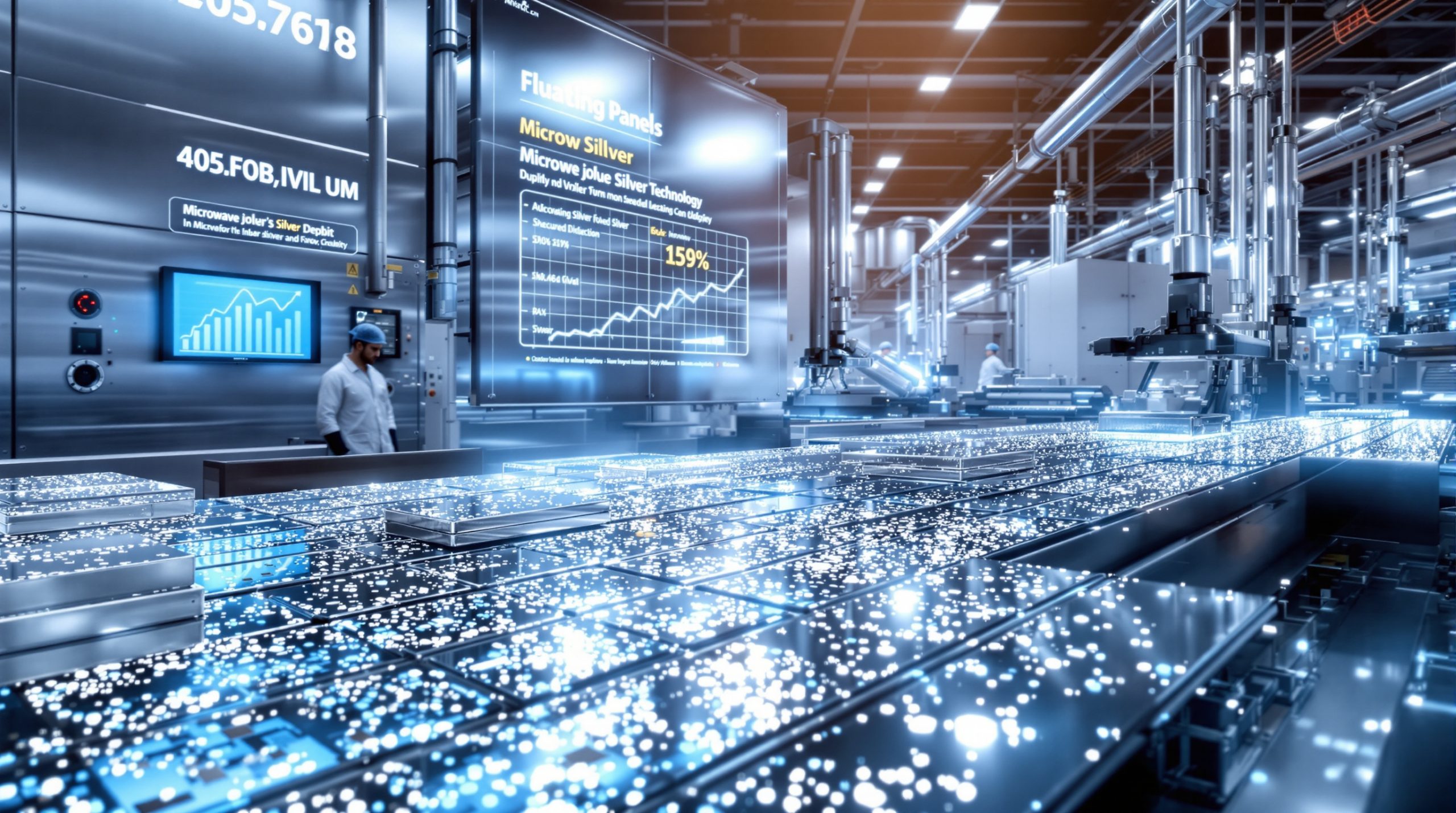Advanced Copper Recovery Technologies: Revolutionizing Extraction Efficiency
How Are Innovative Technologies Transforming Copper Recovery?
The copper industry is witnessing a technological revolution with breakthrough recovery methods delivering unprecedented extraction rates. These innovations are addressing critical challenges in processing efficiency, environmental impact, and economic viability of both primary and secondary copper sources.
Traditional copper extraction has relied heavily on flotation processes with recovery rates typically capped at 75-85%. Modern technologies are pushing these boundaries, with some achieving over 95% recovery rates through innovative leaching techniques, advanced electrochemical processes, and catalytic enhancements.
The economic implications of this improvement are substantial. When recovery rates increase from 80% to 95%, mining operations can extract significantly more copper from the same ore body, fundamentally transforming project economics while reducing waste material.
The Evolution of Copper Recovery Methods
Copper recovery technology has progressed dramatically from basic pyrometallurgical methods to sophisticated hydrometallurgical and electrochemical systems. This evolution has been driven by the need to process increasingly complex and lower-grade ores while meeting stricter environmental regulations.
Early recovery methods focused primarily on high-grade ores with simple mineralogy. As these deposits became depleted, the industry developed more sophisticated techniques to handle complex, low-grade resources. Today's advanced technologies represent the culmination of decades of research aimed at maximizing metal recovery while minimizing environmental impacts.
What Makes Modern Copper Leaching Technologies Superior?
Chloride-Based Leaching: The Next Generation Solution
Chloride leaching represents a significant advancement over conventional acid leaching and flotation processes. This technology operates through a controlled chemical environment that selectively dissolves copper minerals while leaving gangue materials intact.
The process leverages the unique properties of chloride ions to enhance copper mineral dissolution rates and selectivity. Unlike traditional sulfate-based systems, chloride leaching creates conditions that accelerate copper mineral dissolution while operating at milder conditions.
Key advantages include:
- Operates at coarser grind sizes (reducing energy consumption by 15-25%)
- Achieves 90-95% recovery rates compared to 75-85% with traditional flotation
- Requires shorter residence times (4-6 hours versus 12-24 hours)
- Eliminates need for complex multi-stage grinding and flotation circuits
Recent implementations have demonstrated that chloride leaching can process ore at approximately 400 tons per hour through simplified tank systems, significantly reducing the complexity of processing operations.
Technical Advantages of Chloride Leaching Systems
-
Simplified Processing Flow: Direct tank leaching reduces equipment requirements and operational complexity
-
Reduced Power Consumption: Lower grinding requirements translate to 20-30% energy savings
-
Enhanced Metal Selectivity: Preferential dissolution of copper minerals improves concentrate quality
-
Decreased Water Usage: Closed-loop systems reduce freshwater requirements by up to 40%
-
Lower Carbon Footprint: Reduced energy and reagent consumption decreases CO₂ emissions by 15-25%
The ability to operate at coarser grind sizes represents a particularly significant advantage, as grinding typically accounts for 30-40% of processing energy consumption in conventional copper operations. By reducing this energy-intensive step, chloride leaching delivers substantial cost savings while simultaneously reducing carbon emissions.
How Do Pressure Oxidation Systems Enhance Copper Recovery?
High-Pressure Oxidation Technology
Advanced pressure oxidation (POX) systems represent another frontier in copper recovery technology, particularly for refractory and complex sulfide ores that resist conventional processing methods.
POX technology utilizes elevated pressure and temperature conditions to rapidly oxidize sulfide minerals, releasing encapsulated copper and making it available for subsequent recovery steps. This approach is particularly valuable for ores containing minerals like chalcopyrite, which is notoriously difficult to process through conventional methods.
Key operational parameters include:
-
Operating Parameters: Utilizes temperatures of 180-225°C and pressures of 15-30 bar
-
Recovery Efficiency: Achieves up to 99% copper extraction from sulfide concentrates
-
Process Integration: Combines with solvent extraction and electrowinning to produce LME Grade A cathodes
-
Environmental Benefits: Closed-loop water recycling and sulfur capture systems minimize ecological impact
The ability to achieve near-complete copper extraction from complex sulfide concentrates represents a game-changing capability for deposits that were previously considered marginal or uneconomic due to metallurgical challenges.
Case Study: Commercial Implementation
A major copper producer implemented pressure oxidation technology at their processing facility in 2023, resulting in:
-
18% increase in overall copper recovery
-
22% reduction in operating costs per pound of copper produced
-
35% decrease in freshwater consumption
-
Payback period of 2.3 years on capital investment
This implementation demonstrates the commercial viability of pressure oxidation technology and its potential to transform the economics of complex copper projects. The rapid payback period is particularly noteworthy, as it addresses one of the key barriers to technology adoption in the mining industry.
What Role Does Electrochemical Recovery Play in Modern Copper Processing?
Advanced Electrochemical Extraction Methods
Electrochemical technologies are transforming copper recovery from both primary and secondary sources through selective dissolution and precise deposition mechanisms. These methods leverage electrical potential differences to selectively extract and purify copper with minimal chemical inputs.
Modern electrochemical processes represent a significant advancement over traditional methods, incorporating sophisticated control systems, advanced electrode materials, and optimized cell designs to maximize efficiency and product quality.
Table: Comparison of Electrochemical Recovery Methods
| Technology | Recovery Rate | Energy Consumption | Capital Cost | Suitable Materials |
|---|---|---|---|---|
| Electrowinning | 92-98% | 2,000-2,500 kWh/t Cu | Medium | Leach solutions |
| Electrorefining | 99.5%+ | 300-400 kWh/t Cu | High | Blister copper |
| Electroextraction | 85-95% | 1,500-2,000 kWh/t Cu | Low-Medium | E-waste, scrap |
| Electrodeposition | 90-97% | 1,800-2,200 kWh/t Cu | Medium | Complex concentrates |
Each method offers distinct advantages for specific applications, with selection depending on feed material characteristics, desired product specifications, and available infrastructure.
Innovative Applications in E-Waste Processing
Electrochemical recovery has proven particularly valuable for processing electronic waste, where:
-
Selective dissolution techniques can separate copper from precious metals
-
Recovery rates of 95%+ can be achieved from circuit boards and electronic components
-
Purity levels of 99.99% can be attained without secondary refining
-
Process economics remain favorable even at small scales (1-5 tonnes/day)
The ability to selectively recover copper and other valuable metals from complex electronic waste streams represents a significant advancement in urban mining and circular economy applications. These technologies enable the economic processing of materials that would otherwise be landfilled or exported to regions with less stringent environmental regulations.
How Are Biological Methods Advancing Copper Recovery?
Bioleaching and Biomining Technologies
Microbial-assisted extraction represents a growing field in copper recovery, particularly for low-grade ores and waste materials previously considered uneconomic. This approach harnesses naturally occurring or engineered microorganisms to catalyze metal dissolution processes.
Bioleaching offers unique advantages in specific applications, particularly for low-grade resources where conventional processing would be prohibitively expensive. The technology leverages the metabolic activities of specialized microorganisms to catalyze the oxidation of sulfide minerals, releasing copper into solution for downstream recovery.
Key features include:
-
Microbial Catalysts: Specialized bacteria like Acidithiobacillus ferrooxidans accelerate copper dissolution
-
Application Methods: Heap leaching, tank leaching, and underground copper mining tech
-
Recovery Rates: 65-85% from low-grade materials (0.3-0.8% Cu)
-
Environmental Profile: Reduced chemical usage and lower energy requirements
-
Economic Threshold: Makes extraction viable from ores as low as 0.2% copper content
Bioleaching provides a particularly valuable option for processing marginal resources and mine waste that would otherwise remain unutilized. By enabling the economic extraction of copper from these materials, bioleaching contributes to resource maximization while potentially addressing legacy environmental issues.
Emerging Bioengineered Solutions
Recent advances in synthetic biology are enhancing bioleaching capabilities:
-
Genetically modified microorganisms with 30-50% faster leaching rates
-
Engineered consortia that function effectively across wider pH ranges (1.5-4.0)
-
Temperature-resistant strains that maintain activity at 45-60°C
-
Reduced sensitivity to inhibitory elements like arsenic and antimony
These bioengineered solutions address some of the traditional limitations of bioleaching, such as slow kinetics and sensitivity to adverse conditions. As these technologies mature, they promise to expand the range of materials suitable for bioprocessing while improving overall efficiency and economics.
What Economic Impact Do Advanced Recovery Technologies Deliver?
Financial Benefits of Enhanced Recovery Systems
The implementation of advanced copper recovery technologies can transform project economics through multiple pathways:
-
Increased Metal Production: 10-15% more recoverable copper from the same resource base
-
Capital Efficiency: 15-25% reduction in processing plant capital requirements
-
Operating Cost Reduction: $0.10-0.30 per pound decrease in production costs
-
Project NPV Enhancement: 20-40% improvement in net present value at conservative pricing
These economic benefits can be particularly significant for marginal deposits or brownfield expansions, where improved recovery rates may provide the necessary boost to achieve economic viability. For established operations, technology upgrades can extend mine life and enhance profitability through increased metal production and reduced operating costs.
Case Study: Economic Transformation
A mid-tier copper project in Australia implemented chloride leaching technology in 2024, resulting in:
-
Increase in post-tax NPV from A$802 million to A$855 million at base case pricing
-
Potential NPV of A$1.2 billion at spot copper prices
-
Reduction in capital expenditure by A$74 million
-
Simplified project financing due to reduced technical risk profile
-
Elimination of dependency on volatile cobalt markets while maintaining future optionality
This case demonstrates how technological innovation can fundamentally transform project economics. The improvement in NPV, combined with reduced capital requirements and technical risk, significantly enhanced the project's attractiveness to investors and financiers.
How Are Recycling Technologies Advancing Copper Recovery?
Next-Generation Copper Recycling Methods
Copper recycling technologies have evolved significantly beyond traditional melting and refining approaches:
-
Upward Casting Method: Produces ultra-high-purity copper (99.99%+) for electronics applications
-
Continuous Casting and Rolling (CCR): Enables direct conversion of scrap to semi-finished products
-
Advanced Separation Technologies: Optical sorting, eddy current separation, and X-ray transmission systems
-
Chemical Recycling Processes: Selective dissolution and precipitation of copper from complex scrap
These technologies enable the recovery of copper from increasingly complex and contaminated waste streams, expanding the range of materials that can be economically recycled. Advanced separation systems in particular have revolutionized the ability to process mixed metal scrap that was previously difficult to handle.
Environmental and Economic Benefits of Advanced Recycling
Modern copper recycling technologies deliver substantial sustainability advantages:
-
85-90% energy savings compared to primary production
-
70-75% reduction in carbon emissions per tonne of copper produced
-
Water consumption reduced by 40-60% versus conventional mining and processing
-
Recovery of valuable trace elements including precious metals and rare earths
The energy savings alone represent a compelling argument for maximizing copper recycling, particularly as energy costs rise and carbon pricing mechanisms become more widespread. Additionally, recycling reduces dependence on primary mining, mitigating associated environmental impacts and resource depletion.
What Are the Most Promising Emerging Copper Recovery Technologies?
Breakthrough Innovations in Development
Several cutting-edge technologies are approaching commercial implementation:
-
Catalytic Heap Leaching: Proprietary catalysts that modify mineral surfaces to enhance acid penetration, potentially doubling extraction rates from primary sulfides
-
Adaptive pH Leaching Platforms: Flexible chemical extraction systems that adjust pH and oxygen concentration in real-time based on ore characteristics
-
Supercritical Fluid Extraction: Using CO₂ in supercritical state as a solvent for selective copper extraction at lower temperatures and pressures
-
Direct Electrochemical Reduction: Converting copper minerals directly to metal without intermediate solution stages, reducing energy requirements by 30-40%
-
Quantum Dot Recovery Systems: Nanoscale materials that selectively bind copper ions from dilute solutions, enabling recovery from waste streams below 100 ppm
These emerging technologies represent the next frontier in copper recovery innovation, offering potential step-changes in efficiency, selectivity, and environmental performance. Many leverage advanced materials, precision control systems, and novel chemical approaches to address longstanding challenges in copper processing.
Commercial Implementation Timeline
| Technology | Development Stage | Projected Commercial Availability | Potential Recovery Improvement |
|---|---|---|---|
| Catalytic Heap Leaching | Commercial Demonstration | Currently Available | 15-25% |
| Adaptive pH Platforms | Pilot Testing | 2026-2027 | 10-20% |
| Supercritical Extraction | Laboratory Scale | 2028-2030 | 20-30% |
| Direct Electrochemical | Proof of Concept | 2029-2031 | 25-35% |
| Quantum Dot Systems | Research Phase | 2030-2032 | 30-40% |
This timeline reflects the current state of development and projected commercialization paths for key emerging technologies. Early-stage implementations often focus on niche applications or specialized materials before expanding to mainstream copper processing operations.
How Do Copper Recovery Technologies Impact Sustainability Goals?
Environmental Performance Metrics
Advanced copper recovery technologies contribute significantly to sustainability objectives:
-
Water Conservation: Closed-loop systems reduce freshwater consumption by 30-60%
-
Energy Efficiency: Modern processes reduce energy requirements by 15-40%
-
Land Disturbance: Enhanced recovery reduces waste rock and tailings volumes by 10-30%
-
Chemical Usage: Selective technologies decrease reagent consumption by 20-50%
-
Carbon Footprint: Reduced energy and improved efficiency lower CO₂ emissions by 15-35%
These environmental benefits address several of the most significant sustainability challenges facing the mining industry. Water conservation is particularly critical, as many copper-producing regions face increasing water scarcity and competition among users.
Alignment with ESG Investment Criteria
The implementation of advanced recovery technologies addresses key environmental, social, and governance considerations:
-
Environmental: Reduced emissions, water usage, and waste generation
-
Social: Decreased community impacts through smaller footprints and reduced emissions
-
Governance: Enhanced resource stewardship and improved operational transparency
-
Economic: Sustainable value creation through resource optimization
As ESG considerations become increasingly important in investment decisions, mining companies that adopt advanced recovery technologies may gain preferential access to capital and improved stakeholder relations. This alignment creates a virtuous cycle where economic and sustainability objectives reinforce each other.
What Challenges Remain in Advanced Copper Recovery Implementation?
Technical and Operational Considerations
Despite significant advances, several challenges persist in implementing cutting-edge recovery technologies:
-
Scale-Up Complexity: Bridging laboratory success to commercial implementation
-
Variability Management: Ensuring consistent performance across diverse ore types
-
Capital Requirements: Securing investment for first-of-kind commercial installations
-
Operational Expertise: Developing specialized knowledge for advanced process operation
-
Integration Challenges: Incorporating new technologies into existing processing circuits
These challenges are particularly acute for junior mining companies and brownfield operations, where capital constraints and existing infrastructure may limit technology adoption options. Industry collaboration and partnership models may help address these barriers by distributing risk and sharing knowledge.
Risk Mitigation Strategies
Leading companies are addressing implementation challenges through:
-
Comprehensive variability testing across representative ore samples
-
Staged implementation beginning with pilot plants before full-scale deployment
-
Strategic partnerships with technology providers and research institutions
-
Detailed geotechnical and resource characterization to optimize process design
-
Phased development approaches that reduce initial capital requirements
These strategies help manage the technical and financial risks associated with adopting new recovery technologies. By taking a systematic, staged approach to implementation, companies can build confidence in technology performance while limiting initial capital exposure.
Conclusion: The Future of Copper Recovery Technology
The evolution of copper recovery technologies represents a critical advancement for meeting growing global demand while addressing sustainability imperatives. These innovations are transforming project economics, reducing environmental impacts, and enabling the development of resources previously considered uneconomic.
As the global energy transition accelerates, driving surging copper demand trends, these technological breakthroughs will play an increasingly vital role in ensuring adequate supply while minimizing ecological footprints. Companies that successfully implement these advanced recovery methods will likely gain significant competitive advantages through enhanced resource utilization, improved cost structures, and superior environmental performance.
The coming decade will likely see continued rapid innovation in this field, with technologies currently in development stages reaching commercial implementation and delivering further improvements in recovery rates, energy efficiency, and environmental performance.
Industry collaboration, supportive policy frameworks, and continued research investment will be essential to accelerate the development and adoption of sensor technology in copper mining. As copper's role in the global energy transition becomes increasingly critical, unlocking copper investment strategies becomes not just an economic imperative but a societal one as well, with particularly promising opportunities emerging through US copper project insights.
Disclaimer
This article contains forward-looking statements regarding copper recovery technologies and their potential impacts. Future performance of these technologies may vary based on site-specific conditions, ore characteristics, and implementation details. Readers should consult with qualified technical and financial advisors before making investment decisions based on the technologies discussed.
Interested in Transforming Your Copper Investment Strategy?
Discover how to leverage cutting-edge copper recovery technologies to maximise your investment returns with Discovery Alert's proprietary Discovery IQ model, which instantly identifies significant ASX mineral discoveries and turns complex data into actionable insights. Explore historic mining discoveries and their substantial returns by visiting Discovery Alert's dedicated discoveries page.




